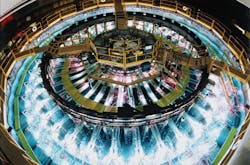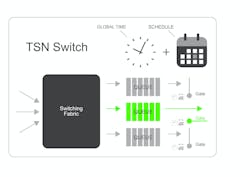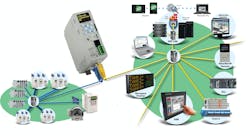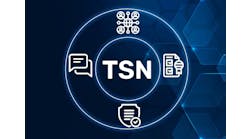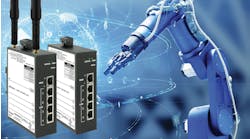For an in-depth explanation of what exactly time-sensitive networking is, read "What is time-sensitive networking?"
For an explanation of how automobile makers and manufacturing engineers have pushed and pulled each other into time-sensitive networking, read "From AVB to TSN in the automotive industry."
TSN is a set of IEEE 802 standards designed to enhance Ethernet networking to support latency-sensitive applications that require deterministic network performance.
The goal of the IIC testbed is to display the value of new Ethernet IEEE 802 standards, referred to as TSN, in an ecosystem of manufacturing applications (Figure 1). TSN powers a standard, open network infrastructure that supports multi-vendor interoperability and integration, as well as real-time control and synchronization between motion applications and robots, for example, over an Ethernet network.
At the same time, TSN is designed to support traditional traffic found in manufacturing applications; this can’t be accomplished without the convergence of IT and operational technologies.
“This testbed seeks to discover and invent new products and services leveraging the Internet of Things in industrial systems,” says Dr. Richard Soley, executive director of the IIC. “The testbed developers realize that their markets will be disrupted by IoT and are developing this testbed to discover and invent that disruption. This testbed will prove the value and functionality of IEEE 802 time-sensitive networks in machine-control applications.”
Figure 1: The goal of the IIC testbed is to display the value of new Ethernet IEEE 802 standards, referred to as TSN, in an ecosystem of manufacturing applications. (Source: IIC)
Testbeds are a major focus and activity of the IIC and its members. “Our testbeds are where the innovation and opportunities of the industrial Internet—new technologies, new applications, new products, new services and new processes—can be initiated, thought through and rigorously tested to ascertain their usefulness and viability before coming to market,” explains Soley.
The testbed will combine different critical control traffic, such as OPC UA, and best-effort traffic flows on a single, resilient network based on IEEE 802.1 TSN standards. It will demonstrate TSN’s real-time capability and vendor interoperability using standard, converged Ethernet, and it will assess the security value of TSN and provide feedback on the ability to secure initial TSN functions. Equally important is the testbed’s attempt to show the IIoT’s ability to incorporate high-performance and latency-sensitive applications.
In the past, real-time control applications typically were deployed using nonstandard network infrastructure or unconnected networks that left the devices and data siloed and difficult to access. TSN’s value is in unlocking data in real time and fulfilling the IIoT promise of improved productivity from big data analytics and smarter systems.
IEEE 802.1 is the specification for switch operation. “One aspect we’re focusing on in this testbed is scheduling,” explains Todd Walter, chief marketing manager, National Instruments (NI), and industrial segment chair, AVnu Alliance. “The profile of IEEE 1588 for precision time protocol (PTP) is to distribute time and synchronize all of the end nodes and all of the switches, so they all have common concepts of time, or synchronized time. Switches already have the ability to look at a packet and put it in different queues. TSN creates a reservation for a particular packet at a particular time. The bridge can identify the packet and gives it a fully scheduled pass through the network. For control applications, that’s ideal.”
Also read: Why deterministic Ethernet matters to manufacturing
Figure 2: The testbed is physically hosted at the National Instruments campus in Austin, Texas. Cisco and TTTech are supplying the switching. The major components are scheduled to be integrated by the third quarter of 2016. (Source: TTTech)
The testbed is focused around smart manufacturing because TSN will have applicability across a lot of industries. IIC member companies bring their own devices to the testbed. “One application we’ll test will be machine-to-machine coordination between a robot and another machine,” explains Walter. “A robot has a controller, sensors, actuators, drives and motors. We’ll communicate through some standard interfaces and commands to coordinate the robot controller with another machine that has motion, sensor or vision integration; and we’ll be able to put those multiple controllers together with multiple systems being coordinated—for example, coordinating a Kuka robot with a Bosch Rexroth motion system. We’ve structured the testbed to be able to support many standard protocols.”The testbed is physically hosted in Austin, Texas, at the National Instruments campus, where NI is handling the design. Cisco and TTTech are supplying the switching (Figure 2). The major components are scheduled to be integrated by the third quarter of 2016. “We plan to come out with feedback to the conformance bodies and then reference architectures and guidance by the fourth quarter,” explains Walter.
Security and safety
For TSN, security has to be designed-in as a layered system, explains IIC’s Soley. “One cannot add security as a new feature later,” he warns. “Air-gapping, while the obvious approach to perimeter security, has major drawbacks—most obviously the loss of the air-gap, that is, the accidental or intentional connection of a supposedly air-gapped system to the Internet. But, more pervasively, air-gap security ignores the fact that the vast majority of security failures are perpetrated by insiders. Air-gap security, as a perimeter measure, cannot guard against insider threats. The developers for this IIC testbed are aware of the issues and developing their time-sensitive networks with security in depth designed-in.”
The security level needs to be pushed as far down as possible, adds NI’s Walter. “When there’s a network infrastructure that’s open, that creates a security hole,” he cautions. “If you can get access to that layer, you can get everywhere. We want to push security all the way into the end node. In addition to being able to adopt all of the IT best practices for security, we can add another layer of security because we have information about the data flows. We know the timing and the path, and that can be another powerful tool for the layers of security. In the testbed, we want to figure out what we can apply that’s already in use and what we also can add.”
Because TSN is standard Ethernet, control networks can take advantage of best practices for security that have been developed into Ethernet for decades, says Walter. “Additionally, TSN enables an additional layer of security to the data,” he explains. “The precise timing mechanism allows you to know exactly when the data was sent and when it is supposed to arrive, based on the packet information; therefore, you can see if someone else has accessed the network and intercepted or altered it. AVnu Alliance is evaluating additional security layers in TSN currently, as security is critical to these networks.”
Expectations would be that security for time-sensitive networking would use the same black-channel principles for the current fieldbus solutions, notes Dr. Michael Hoffmeister, portfolio manager, software, at Festo. “The strength of Ethernet-based protocols in general is the layered approach where each layer in a protocol stack adds a certain functionality to the entire communication channel,” he says. “The TSN layer adds the real-time capabilities to the communication channel while security is considered on higher protocol layers using, for example, the security mechanisms of OPC-UA.”
For cybersecurity, various aspects, including authentication, encryption and data security are being considered. “The point is to protect critical data and block unwanted data,” explains Sari Germanos, open automation business development manager, B&R Industrial Automation.
Security in time-sensitive applications is sometimes circumvented by using physical security, such as completely isolated and dedicated networks, instead of electronically derived security, such as public key encryption of the data, explains Doug Taylor, principal engineer, Concept Systems, a system integrator in Albany, Oregon. “Latency-intolerant paradigms are usually local by nature, lending themselves to physical security,” he says.
One substandard for TSN is Time Based Ingress Policing (IEEE 802.1Qci). “This standard defines mechanism to count and filter frames, and it supports policing and service class selection,” explains Dipl. Ing. André Hennecke, researcher at DFKI, a research center in Kaiserslautern, Germany. “These mechanisms help against different network attack vectors like ‘man in the middle’ attacks, but also against faulty network components. Even when a flow gets hijacked, the flow still relies on the reserved stream and all frames outside the stream time window get dropped, which leads to a more secure network.”
TSN also will lead to a new challenge when it comes to security design. “To realize all functionalities of TSN successfully, a central network management component is needed,” advises Hennecke. “This management component helps in coordinating stream reservation or path control, compared with a classic hop-by-hop method, but leads also to higher security threat. The penetration of this management component can influence the whole network, depending on the functionality and implementation, which is still open.”
Protocols that reside on Ethernet and use the traditional TCP/IP protocol suite have security vulnerabilities, warns Sloan Zupan, senior product manager, Mitsubishi Electric Automation. “Customers should choose a deterministic network which has the benefits of traditional Ethernet networks but doesn’t solely rely on the TCP/IP protocol suite,” he says. “Networks such as CC-Link IE provide protection against cybersecurity risks, which aren’t available from other Ethernet networks, and it is 100% deterministic.”
If your network knows when it’s supposed to be receiving information, it can more easily push away information when it’s not anticipated, says Steve Zuponcic, technology manager at Rockwell Automation. “It’s easier to filter out things that are not expected when they’re not expected,” he says.
However, in some ways, TSN doesn’t change the dynamics of security in a network, says Paul Brooks, business development manager at Rockwell Automation. “You’ve got management software and devices and switches,” he says. “Changes in the performance of those also changes the performance of the system. Those changes have to be secure. We would expect many of the same techniques to be used. The threat vectors are very similar.”
Deterministic Ethernet also can influence the way that safety systems are implemented, claims Markus Plankensteiner, vice president, sales industrial, North America, and global alliance manager, TTTech Computertechnik. “The fact that scheduled traffic flows can be isolated and not disturbed by other traffic on the network is very important,” he states. “By scheduling messages from safety applications, we can ensure high availability of safety systems even when converged with the wider network infrastructure.” Plankensteiner believes this will lead to a streamlining of safety systems and associated overheads without affecting the safe performance of the overall system.
“Safety always will take a path using older technology that has proven itself, rather than embrace newer technology, primarily because the decision makers in the safety field are risk-averse,” cautions Taylor. “Once the technology is commonplace and the failure modes are all well-known, then it will be considered for safety, regardless of the advantages it offers.”
[pullquote]
The first phase of the TSN testbed, for instance, hasn’t factored in safety. “The most common way to do communications over any network infrastructure is black channel, where you build your safety structure, assuming the communications medium is not certified,” explains Walter. “It allows you to use off-the-shelf, but what is the latency through the network? You’re encapsulating in a safe domain, and then you decapsulate on the receiver and make sure it matches. That black-channel concept theoretically should apply very well to a TSN infrastructure. This is a long-term testbed so we could add it in the future. It’s just not part of this first phase.”
Brooks, however, thinks deterministic Ethernet will have no impact at all on system safety. “Safety protection systems are designed to move to a safe state in the event of any interference. TSN delivers some benefits. It’s easier to architect a system with no disturbances. The likelihood of a disturbance will be reduced. It also brings redundancy to the table. It’s a more reliable network, so the safety protection system will be less susceptible to trips or disturbances,” he notes.
“Safety is a vital part of our industry, and, as Ethernet becomes more and more prevalent, the two will have to cross paths at some time,” predicts Bill Dehner, technical marketer, AutomationDirect. “Safety is time-critical and as such will undoubtedly force Ethernet further into the deterministic realm. As seen with precision motion applications, protocols such as EtherCAT that use precision time protocol synchronization—IEEE 1588—are already being used to accommodate time-sensitive applications, and safety will further this effort.”
To be determined
Deterministic Ethernet is one of the foundation technologies for the industrial Ethernet, explains Paul Didier, solutions architect manager at Cisco. “We’ll be able to connect up a lot more devices and a lot more machines,” he says. “Because of that, it will enable this IIoT. Initially it will be preventive maintenance, then operational, then robot as a service and then car as a service. A lot needs to come into the IIoT, but none of it works if you can’t access the devices. You need that access to the devices and data and control loops. Fanuc is now becoming an engineering company providing a service, not just a robot company. I see this as being one of the big challenges for the IoT—getting these devices interconnected. I don’t want to say TSN is the key to these IoT models. Getting connectivity access is important because so many are still not connected. And all of the proprietary little schemes mean the data is really hard to get to.”
Deterministic Ethernet already exists, says Phil Marshall, CEO of Hilscher North America. “Standard Ethernet chips provide a level of determinism that is quite good at many slower application requirements—for example, in the 10 ms response time offered by standard Modbus TCP,” he explains. “To provide determinism for high-speed applications, the Ethernet protocol standard organizations have used IEEE 1588. The industry issue is that the IEEE 1588 functions are not interoperable. Profinet, EtherNet/IP and other deterministic IEEE 1588-based Ethernet protocols are incompatible with each other. TSN may perhaps provide a common clock mechanism to create a universal protocol suitable for high-speed discrete parts manufacturing.”
Joey Stubbs, P.E., North American representative, EtherCAT Technology Group, agrees. “Specifically, EtherCAT is a widely used Ethernet protocol for machine control using standard 100Base-TX Ethernet as the physical layer for high-speed, highly deterministic control of extremely complex and sophisticated machines and processes used across a wide range of industries and applications.”
Deterministic Ethernet will make it easier to consolidate multiple control systems onto a larger compute node, thereby reducing the complexity of hardware on manufacturing floors, predicts Mark Hermeling, director, product management, VxWorks, Wind River. “It will also facilitate connectivity between machines, providing the capability to do tighter integration of manufacturing lines,” he says.
It will lay the communications platform for Industrial IoT, says TTTech’s Plankensteiner. “The Industry 4.0 initiative has explicitly set out to use open standards for its reference architecture model,” he explains. “TSN now imbues IEEE Ethernet with the real-time features that were previously only available in proprietary protocols,” he says. “This means standard Ethernet being used all the way from the enterprise cloud down to the machine sensors for applications including low-latency motion, high-availability processes and safety control. If the goal of Industrial IoT can be somewhat bluntly condensed to ‘better use of machine data,’ then it is deterministic Ethernet that will enable the collection and use of this data in a standard, interoperable way.”
Deterministic Ethernet will have a tremendous impact on certain specialized users but will have a minimal impact on the general user, says Concept Systems’ Taylor. “Most people feel that their processes are time-critical, but they are thinking in human time and not computer time. In human time, 50 ms is the blink of an eye. To a computer, 50 ms is nearly an eternity,” he explains.
If and only if deterministic Ethernet will contribute to a simplification of industrial communication in the future, then there is potential to form a globally used technology base in industrial applications.” —Armin Pühringer, Hilscher Gesellschaft für Systemautomation
The impact of deterministic Ethernet on industrial communication is twofold, says Armin Pühringer, business development manager, Hilscher Gesellschaft für Systemautomation. “The real-time synchronous mechanisms are of interest, also for the existing real-time Ethernet standards which are used in industrial environments today,” he explains. “If and only if deterministic Ethernet will contribute to a simplification of industrial communication in the future, then there is potential to form a globally used technology base in industrial applications.”
Ultimately, what deterministic Ethernet enables is intelligent networked components’ ability to communicate with one another with dedicated time intervals and bandwidth, says Mitsubishi’s Zupan. “Machines have a wealth of information in them that can be used to improve operational efficiencies, but pulling this information from sensor devices and other automation components can burden the nondeterministic networks used in today’s automation networks,” he explains, adding that deterministic networks should handle cyclic and transient messages separately and with different priority.
A well-architected network is deterministic today, advises Rockwell’s Brooks. “TSN will provide engineers a tool to build that well-architected network,” he explains. “Bringing fast lanes to the network will make it easier to build.”
TSN is driving the whole concept of a system view of the network, explains Rockwell’s Zuponcic. “You lay things out more at a higher level, versus components, which allows you to design at a system level and make it easier to design those networks,” he says.
Much of the existing network infrastructure is not equipped to handle time-sensitive data such as critical control and fault detection data that must be processed, shared and acted upon immediately, regardless of other network traffic. “Many industrial systems and networks were designed according to the Purdue model for control hierarchy in which multiple, rigid bus layers are created and optimized to meet the requirements for specific tasks,” says NI’s Walter. “Each layer has varying levels of latency, bandwidth and quality of service, making interoperability challenging and flexibly changing data connections virtually impossible.” In addition, proprietary Ethernet derivatives have limited bandwidth and require modified hardware.
“The first meeting for the IEEE 802 standards was held in 1980,” says Walter. “It’s been continually added to. That’s definitely going to be true with the time-sensitive features. I fully expect these capabilities will be built on forever. One thing the Ethernet community has been extremely good about is ensuring the backward- and forward-compatibility. We can start building on this right away.”
Deterministic Ethernet allows machines to synchronize and interoperate in a standard way, especially when combined with an open architecture such as OPC UA, explains B&R’s Germanos.
Its use as a control network could replace other networks such as Profibus and DeviceNet, predicts Mike Justice, president, Grid Connect.
Applications accepted
One example of an application that requires a deterministic network is a web printing press, offers Mitsubishi’s Zupan. “In this application, you have one or more controllers talking with upward of 100 axes of motion and hundreds of I/O points,” he says. “The tension of the material and the torque to move the material through the press must quickly adjust as the roll of material is consumed. I/O control, motion commands and HMI updates, for example, all need to be in sync for the machine to run at an optimal level.”
Many examples of latency-sensitive applications already are kept separate from the wider infrastructure by gateways or proprietary solutions. “In a discrete automation plant with multiple robots working on production lines, TSN will enable far greater operational flexibility,” predicts TTTech’s Plankensteiner. “Today, these robots are controlled locally, with limited synchronization between them and bottlenecks for data access from beyond the factory floor. Where there is connectivity, it is either done over proprietary networks or via gateways. By removing local control functions or converging noncritical traffic in the same network, one could jeopardize the guarantees for communication of critical messages.”
By using a TSN connection between robots, the controls communication is guaranteed across the network, even when converged with noncritical traffic, and all robots are synchronized to the same global time, explains Plankensteiner. “This means that controls networks can be integrated with data networks, and many control functions can be centralized away from the robot cell into a controls cloud where greater computing power can be utilized,” he says. Huge amounts of data from the robots then would be visible to higher-layer networks without the need for gateways, enabling machine-as-a-service (MaaS) type of business models, which simultaneously improves service and maintenance from machine builders and lowers capital expenditure for end users (Figure 3).
Figure 3: By using a TSN connection, the controls communication is guaranteed across the network, even when converged with noncritical traffic. Controls networks can be integrated with data networks, and many control functions can be centralized where greater computing power can be utilized. Huge amounts of data are visible to higher-layer networks, enabling machine-as-a-service (MaaS) business models. (Source: AutomationDirect)
“Vision systems that use Gigabit-Ethernet (GigE) cameras often are completely isolated networks where the entire network consists of a network interface controller (NIC) card and a camera with no switches,” offers Concept Systems’ Taylor. “Using a time-sensitive network could lead to camera networks where multiple cameras live on a network in harmony, allowing multiple control systems to utilize their data in real time. In this paradigm, a smart device can morph from a basic source of information to a preparer of key information, thereby reducing the required bandwidth. A case in point would be a camera system that only reported the elements of the image that are changing between frames to the various smart concentrators that can provide real-time full-frame images to clients at the same speed as a dedicated camera-computer network with perhaps less latency than the dedicated full-frame network.”
Obviously, motion applications are latency-sensitive and would benefit from TSN, says Hilscher’s Pühringer, but, more than that, there might be a potential for sensor networks with an extremely high number of nodes.
“Our hope is that everything works better in a TSN environment, whether that’s voice communications, video surveillance or motion control,” says Rockwell’s Brooks. “There are potential benefits, for instance, a 10% increases in axes through a single link for motion control, most of which is delivered through preemption. The strategy is that everything works better with TSN.”
According to DFKI’s Hennecke, latency-sensitive applications that would benefit most from TSN include:
• safety-relevant communications, which are today mostly done by hardwired solutions—for example, safety-certified communication like safety-stop
• motion and robot controls: with a standard communication in these applications, accessing data gets a lot easier, which helps to improve techniques such as predictive maintenance and system optimization
• machine-to-machine communication, which needs low latency and a high synchronization
• high-level applications, which need a more deterministic communication to monitor and control machines in real time—for instance, condition monitoring or high-speed manufacturing execution systems.
“The number of applications that require minimum latency is in the thousands,” says IIC’s Soley. “Machine control systems are the obvious application and the target of the testbed. Systems for which control signals must be received in time, especially for safety and security reasons, require minimum latency. But there will be other, everyday applications of minimum-latency requirements in the Industrial Internet of Things.”
The edge and the cloud
The rise in the number of intelligent devices has made it very clear that decentralized control is within reach. “They demonstrate how functions can be distributed over a network,” explains Festo’s Hoffmeister. “Edge computing will give a better-defined infrastructure to make use of these technologies. Maybe edge nodes can also serve for holding data and functions of passive devices, joining these data and functions with the ability of those intelligent devices. Additionally, they can serve for database and data-intelligence functions, allowing for closed loops in data analytics. In this sense, edge computing and its framework definitions can leverage the vision of autonomous, self-aware production systems.”
Edge computing has piqued the curiosity of many Mitsubishi customers. “We consider sequence CPUs, C-language controllers and IoT gateways to be examples of edge-computing devices that are commonly used by customers to aggregate data and convert it into useful information,” says Mitsubishi’s Zupan.
“It is the habit of every manufacturer to “gild the lily’ in order to drive sales,” warns Concept Systems’ Taylor. “Coupling this with the steady march of technology that is driven by consumer electronics leads us to products that are offered to us to solve problems we didn’t even know we had. This new technology and our lack of familiarization with the myriad offerings is fertile ground for innovators to connect the dots and come up with very desirable features in modern solutions. This edge-computing category is just one of the LEGO blocks that innovators are using, and most of the resistance to the innovations is being offered by experts within the industry, since the designs do not respect well-defined areas of responsibility.”
But edge computing is not new. The programmable automation controller (PAC) is the manifestation of edge computing, says Rockwell’s Brooks. “What the proliferation of intelligent devices is going to do is give companies the capability to build more into edge-computing devices and share more data with the cloud, more prognostic information from the cloud and present to the operator at the edge level,” he explains.
Cloud computing already is moving closer to the edge of the network in the form of fog computing, which is bringing greater intelligence and analytics to the machine world, says TTTech’s Plankensteiner. “Theoretically of course there is no reason why machine control can’t also be executed in this fog/cloud environment,” he explains. “In order to achieve this, there must be guarantees for both the latency and the jitter of communication between machines and the fog/cloud. Deterministic Ethernet in the form of TSN logically extends the cloud concept of virtualization into and through the network. This means that sensor data and actuator commands can be processed from the fog/cloud as multiple virtual machines, each with a dedicated logical communication channel, but over a single converged network. Machine control from the cloud is much closer than you might think.”
Before you can talk cloud, you’ve got to talk Layer 3 network and look at the work by the Internet Engineering Task Force (IETF) on deterministic networking (DetNet), explains Brooks. “For the cloud to happen, there has to be dramatic changes to the performance in wide area networks (WANs),” he says. “Never is a really, really big word, but, in the foreseeable future, it’s hard to imagine real-time control through the cloud. If we had infinite bandwidth in the Internet and infinite processing power in the cloud, we might have a different answer.”
Hilscher’s Marshall points out that HVAC from the cloud exists today, but he agrees high-speed motion control can’t be done yet. “If the motion control systems can be made more autonomous, you do have the ability to move the larger control system to the cloud,” he says.
Whether machine control from the cloud will become a reality depends on the type of machine and the type of cloud, says Wind River’s Hermeling. “There are many levels of “real-time-ness,” varying from minutes to control a device to microseconds or nanoseconds,” he explains. “Controlling your Nest thermostat from the cloud doesn’t have a tight real-time requirement, and that is already a reality. Controlling an industrial robot or manufacturing equipment that requires response times in the low microseconds requires a different architecture.” TSN with an on-premise cloud can reach these types of timeliness, but remote cloud control would be much more difficult.
“It’s foreseeable to provide new recipes from a cloud into a machine, but real-time machine control from the cloud may not be a practical application of the technology,” warns B&R’s Germanos.
First, you must differentiate the term “cloud,” says DFKI’s Hennecke. “There are private, public and hybrid solutions,” he explains. “When it comes to private clouds, which means that the cloud functionalities are located in the private network, machine control from the cloud can become a reality in the near future. There are already solutions to map classic control components such as software functions and the virtualization of control components into cloud computing systems.”
Machines and stations are already executing a large number of different tasks: human-machine interface, recipe management, tracking and tracing, OEE measures, reporting, statistical process control (APC/ SPC), machine control, help and assistance systems and further, Hoffmeister points out. “In this sense, the real-time-enabled machine control is only a fraction of all tasks a machine has to fulfill,” he says. “A cloud technology can address many of these topics in an efficient and user-friendly way. Therefore, ways should be identified how cloud technology can be implemented for many topics while linking and maintaining the real-time excellence of machine control.”
But nothing that’s technically feasible is also practical, warns Hennecke. “Controlling machines from the cloud can also lead to a few issues, especially when the network is faulty or not available,” he cautions. “Commissioning and troubleshooting will be more complicated, and, when the network is not available, the machine stops without the option of further or emergency operation. One concept to overcome these issues is the principle of apps in manufacturing. The idea behind this is to keep the basic operation functionalities in the local machine control and get more process-specific functionalities from the cloud, for example.” Beside these technical issues, data confidentiality, integrity and security become major issues when it comes to public clouds, preventing suitable solutions from emerging, says Hennecke.
Whether machine control from the cloud will ever become a reality depends on the understanding of what the cloud is, agrees Hilscher’s Pühringer. “Hilscher refers to cloud as a technology—as in using the cloud stack and technologies being developed for cloud applications—and not as topology, such as where cloud means connection to the Internet,” he explains.
It’s unlikely that clouds will be used to do machine control, says Zupan. “There are a couple of factors that need to be considered. The first and most important is human safety. Network communication is susceptible to interruptions and outages. If this were to happen in a machine, people can get hurt. Second is the designed purpose of the cloud environment. Cloud services are excellent resources for aggregating data from various sources and providing fast data analysis. But they don’t operate nearly fast enough to handle machines with complex motion capabilities,” he says.
“Machine control, which is inherently time-sensitive—hard real time—is difficult to achieve with the most common networking technologies and thus with most of today's cloud architectures,” says IIC’s Soley. “Local, private clouds, however, are already controlling machines.”
When a machine is working somewhere in the world, the control is going to have to stay close to that, assures Cisco’s Didier. “There are physics and economics and reliability that drives all of that,” he says. “A lot of data is going to come out. One of the cool concepts out there is that people will want to have a cyberphysical representation of the equipment in the cloud. That doesn’t mean the physical plant will be controlled in the cloud. Optimization and maintenance can be done in the cloud and will filter its way back to the machine. Most machines will have to have some close physical control because of physics, latency and economics. You’ll see highly distributed systems, but a lot of cloud data will be generated. I do think you’ll see cases for doing machine control, but these will be based on these cyberphysical concepts.”
Everything that rises must converge
“The controls industry is conservative and will follow the IT market in a few years after security issues are well-addressed,” predicts Grid Connect’s Justice.
“Look at what the IIoT really means,” says NI’s Walter. “What is the value of a control system converged with standard IT? How do I take my control system and start to separate the functions? If I’m trying to close a loop at 100 KHz, it’s better to push that all the way to the edge. But for IoT, if I have information from a lot of control systems and edge devices, I can put that in an analytics package. Maybe it’s an on-site cloud, or fog. I can get very clean access to the data for on-site computing and have multiple layers of control running concurrently.”
Shop-floor control already executes a large number of tasks, many of which already demand a dependable connection into the office. “A greater convergence between shop floor and office floor will give the system architects a greater flexibility to decide where specific tasks or parts of tasks should be fulfilled,” suggests Festo’s Hoffmeister. “We’ll see a greater integration, fewer gateway solutions and more systems that will benefit from the data richness of shop-floor applications.”
The obvious advantages of a convergence between information technology (IT) and operational technology (OT) include access to cloud services, improved security and integration with ERP/MES. “It can also include the wider benefits that come from the standardization of technology, such as a deeper engineering talent pool, increased resource sharing and faster innovation,” offers TTTech’s Plankensteiner.
“The convergence of operational systems with information systems can only be of tremendous value in all industries,” explains IIC’s Soley. “It's amazing that the operational control systems—programmable logic controllers— in most factories have not been connected to the information systems of those factories, despite the need to track just-in-time delivery of factory-floor inputs and outputs.”
Mitsubishi Electric Automation has customers in virtually every industry who have integrated production machines with business systems to some degree, says Zupan. “It is used to keep the business system updated on the actual status of work in process, production asset health, inventory management and quality control,” he explains. “A business system can become much more intelligent when production information is provided to it on a regular basis. However, many of these benefits are better delivered by the edge-computing capabilities of the automated assets.” Data can be transformed into useful information and sent to a variety of business system consumers.
With automation and control, multiple networks are deployed, explains Rockwell’s Brooks. “If they’re wireless, having them in the same space makes them interfere with each other,” he says. “We allow cloud-centric applications, discrete devices and service-based delivery of analytics. You get the ability to start having other services that were never in place before. All of those promises are hard to deliver without a converged network architecture in place to support them.”
Connecting the controls network with the enterprise network also enables equipment health monitoring and maintenance. “The ability of connecting entire machines into the cloud allows for real-time data massaging and data analytics and improved overall factory performance, including capabilities such as predictive maintenance,” says B&R’s Germanos.
“Unifying the network communications at the control level with your IT gives you access from remote sites and gives you analytics,” explains Rockwell’s Zuponcic. “It’s required to enable the IIoT. You can’t accomplish it without it.”


